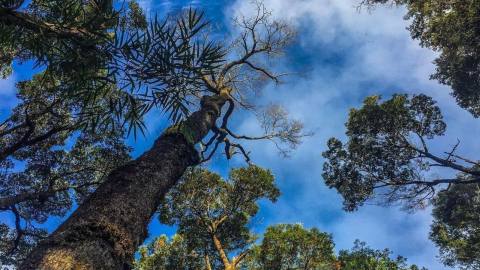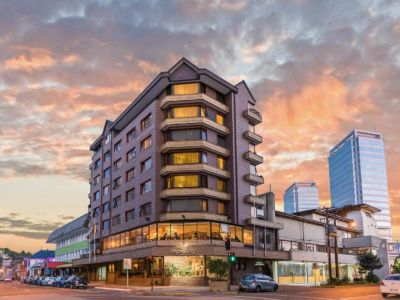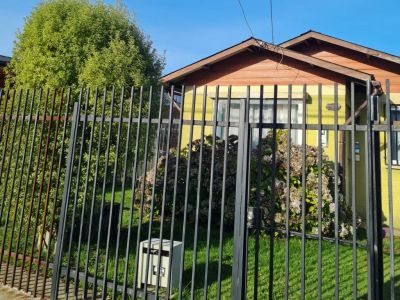No sooner had the brochure reached our hands than the description of the ride changed from being more than promising to becoming an obsession: “Our flight goes over the landscapes of the southern entrance to the South of Chile, covered by forests, volcanoes, lakes, estuaries and islands. The tour shows how this part of the lakes region is formed, with geography features determined by the action of glacial movements, the origin of volcanoes, the erosive force of the water and the wind, and the green blanket of ancient forests that are still preserved…”
Flying among Volcanoes
The control tower itself is an attraction worth a photograph. Its façade is built with alerce tiles, just like the ancient houses of this area of the Chilean lakes. No sooner had the aircraft raised its nose than beautiful sown fields, the vastness of Lake Llanquihue and a fabulous deep blue see were made out in the background and soon became the protagonists of the scene. The small cities of Puerto Varas, Frutillar and Ensenada were left below, just like the sea port city of Puerto Montt, with its crafts and fishermen. The Angelmo harbor and the great island of Chiloé in the distance were left behind as we crossed the green thickness of ancient Alerce Andino National Park, the salmon nets that the Reloncavi Estuary displays from thousands of meters and the mouths of the rivers ending into it. While our questions could not express every single thing perceived by our eyes, Santiago Vidal, the aircraft pilot, described each one of the points standing out from the air due to their magnitude. The Calbuco and Yate Volcanoes, the Tronador and Puntiagudo Mounts, Lakes Chapo, Todos los Santos, Rupanco and Llanquihue, the Alerce Andino and Vicente Pérez Rosales National Parks, all of them were pointed at by the wise finger of who has flown over the area for years.
The Osorno, A Special Volcano
The first volcanoes we made out were the Yates and the Calbuco. But the one that catches our attention most is a dark green and black snow-capped mass with arms of snow that almost reach the base. From the aircraft, we spotted its presence. It is impossible not to. But Santiago had promised us that strawberry for the end of the tour. So we immediately started to approach the Andes Mountain Range. Flying over the vast Lake Todos los Santos, with an intense turquoise color, we could make out the source of the Petrohue River and its famous falls, the Casa Blanca and Puyehue Volcanoes and the National Park bearing the same name. On the other side of the mountain range, and over 3000 meters high, we went speechless as we saw Lake Nahuel Huapi, Mount Tronador with its dark glaciers and Mount Catedral, unique for the two peaks of its summit. There, in the distance, a lonely and huge white mass, which in fact receives the name of Lanín Volcano, would silently watch our flight. Photos here, photos there. The plane made a slow turn and Santiago, with his eyes fixed on ours, simply uttered: “It’s time… To the Osorno.” Our hearts could not believe our eyes. We could not especially believe that, after all the marvelous sights we had just caught, there would be one more that would make the rest look small and insignificant. Lake Puyehue and Lake Rupanco were left behind, just like the beautiful Puntiagudo Volcano. And there it was –the Osorno. Like in the school books pictures and the geography maps. With its classical dark blackish green and ornamented with arms of eternal snow. Its presence began to attract us. The small plane –now small indeed- would approach the white wall as if the mass was in fact a magnet. The summit hypnotized us and towards it we went. Santiago, proud of his volcano, like every Chilean, timidly approached it and we began to fly and photograph it by copying its presence in circles until we were practically close enough as to touch the summit with our own hands. Or in fact, that was what we really wished for … I do not believe that there are proper words to express the sensation we experienced at that moment. No one really has those words, but the only thing I remembered there, until we finally touched down again at Puerto Varas, was that when our friend promised the final strawberry for the end, he surely must have thought of his favorite volcano. We agree. But I think there is one detail missing in the definition of the Osorno: flying around it undoubtedly offers the possibility of appreciating from the air “the most beautiful whipped cream a mountain could have on top …” Pablo Etchevers
Pablo Etchevers
The flights leave from the Puerto Montt or the Puerto Varas aerodrome.






























